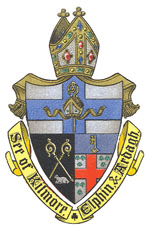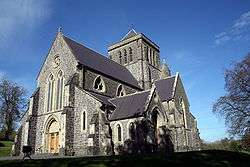Diocese of Kilmore, Elphin and Ardagh
| United Dioceses of Kilmore, Elphin and Ardagh Dioecesis Unitae Kilmorensis, Elphinensis et Ardachadensis Deoisí Aontaithe na Cille Móire, Ail Finn agus Ardach | |
|---|---|
 Coat of arms | |
| Location | |
| Ecclesiastical province | Armagh and Tuam |
| Information | |
| Denomination | Anglican |
| Cathedral |
St Fethlimidh's Cathedral, Kilmore, St John the Baptist Cathedral, Sligo |
| Current leadership | |
| Bishop | Ferran Glenfield, Bishop of Kilmore, Elphin and Ardagh |
| Website | |
| kilmore.anglican.org | |


The United Dioceses of Kilmore, Elphin and Ardagh is a diocese of the Church of Ireland located in central Ireland.[1] It is in the ecclesiastical province of Armagh.
It is one of twelve Anglican dioceses in the island of Ireland. The geographical remit covers all of County Leitrim, almost all of counties Cavan, Longford and Roscommon, plus smaller parts of counties Westmeath, Sligo, Donegal and Fermanagh.
Cathedrals

There had been two other cathedrals, but are now in ruins.
- St Mel's Cathedral, Ardagh was severely damaged by warfare in 1496 and was never restored.
- St Mary's Cathedral, Elphin was destroyed by a violent storm on 4 February 1957 and abandoned in favour of St John the Baptist, Sligo in 1961.
The historic sees of Kilmore and Ardagh were intermittently united in the 17th and 18th centuries until they were finally united in 1839. They were further merged with the see of Elphin in 1841 to form the current Diocese of Kilmore, Elphin and Ardagh. It is for this reason that the united diocese has two cathedrals in current use as well as a number of deconsecrated cathedrals.
Parishes
Each of the dioceses is divided into a number parish groups.[2]
- Diocese of Kilmore
|
|
|
- Diocese of Elphin
|
|
- Diocese of Ardagh
|
List of bishops
|
|
Overview
The three dioceses of Kilmore, Elphin and Ardagh were first created in the early and mid 12th-century. The sees of Elphin and Ardagh were established at the Synod of Rathbreasail in 1111 and the see of Kilmore (originally called Tirbrunensis, Triburnia or Tybruinensis) at the Synod of Kells in 1152.
Following the Reformation in the 16th century, the church in "communion with the Bishop of Rome" used the term "Catholic" to distinguish itself from the various Protestant churches.[4] The Parliament of Ireland broke communion when it created the Church of Ireland as the State Religion in the Kingdom of Ireland assuming possession of most Church property. The English-speaking minority mostly adhered to the either the Church of Ireland or, despite the political and economic advantages of membership in the state church, to Presbyterianism.
See also
- Dean of Kilmore
- Dean of Elphin and Ardagh
- List of Anglican dioceses in the United Kingdom and Ireland
- Roman Catholic Diocese of Kilmore
- Roman Catholic Diocese of Elphin
- Roman Catholic Diocese of Ardagh and Clonmacnoise
References
- ↑ Official diocesan website - History
- ↑ Parishes of Kilmore, Elphin and Ardagh. Retrieved on 21 August 2009.
- ↑ The Revd Ferran Glenfield Elected New Bishop Of Kilmore, Elphin And Ardagh. Church of Ireland Press release, 4 February 2013.
- ↑ McBrien, Richard (2008). The Church. Harper Collins. p. xvii. Online version available Browseinside.harpercollins.com. Quote: "[T]he use of the adjective 'Catholic' as a modifier of 'Church' became divisive only after the East-West Schism ...and the Protestant Reformation ...In the former case, the West claimed for itself the title Catholic Church, while the East appropriated the name Holy Orthodox Church. In the latter case, those in communion with the Bishop of Rome retained the adjective "Catholic", while the churches that broke with the Papacy were called Protestant."
External links
- Diocese of Kilmore, Elphin and Ardagh
- Kilmore Cathedral architecture & stainglass windows (Gloine website)
- Diocese of Kilmore, Elphin and Ardagh official page